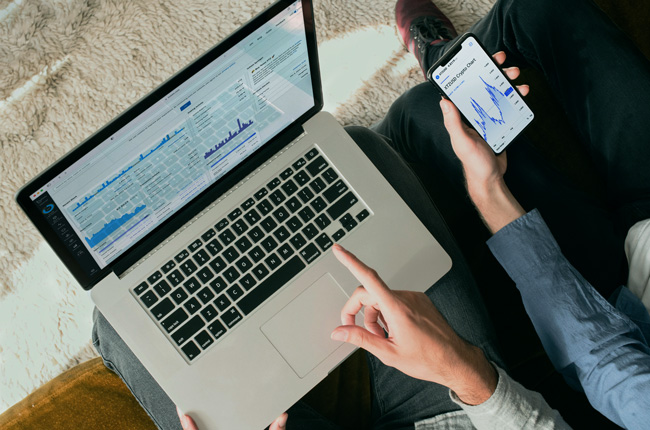
APRIL 4, 2022 • By Matthew Tierney
In March 2022, U.S. President Joe Biden signed an Executive Order that calls on several agencies to work towards a regulatory framework for certain types of digital assets, potentially laying the groundwork for a U.S. central bank digital currency (CBDC).
Professor Andreas Veneris was an advisor on a recent digital asset report from the U.S. think tank the Hoover Institution, and some of the report’s recommendations were implemented by the Executive Order. He was also part of a multidisciplinary team commissioned in 2020–21 by the Bank of Canada to propose an architecture for a potential ‘digital loonie.’ Veneris is from The Edward S. Rogers Sr. Department of Electrical & Computer Engineering and cross-appointed to the Department of Computer Science.
He spoke to writer Matthew Tierney to explain how digital assets and digital currencies operate, the function of blockchain technology, and what Biden’s Executive Order means for Canada.
Digital assets include cryptocurrencies and non-fungible tokens (NFTs). What exactly are they?
In the last decade or so, digital items as something you can trade or exchange, or use for payments, have become more mainstream. The most well-known of these items are cryptocurrencies like Bitcoin, Ethereum and Tether. But the item can be anything digital, as long as people think it has value.
One of the first examples of this was CryptoKitties — virtual cats. Back in 2017, it was a frenzy. Some people were buying them for $100,000. And to be painfully clear here, what they were buying were digital zeros and ones that represent cats.
You might think that’s bizarre, but the market sets the value. It’s just like baseball cards. You can find people who spend $10,000 to buy essentially a piece of paper. Why? There are many reasons someone might find value in a baseball card. Or maybe they think they can sell it later for $20,000.
Now we have non-fungible tokens. NFTs are the equivalent of digitally signed items.
Traditionally, a signature authenticates an item, such as on a painting. Imagine I’m a big-time painter and instead of physically signing my latest picture I put an infrared chip behind the canvas that defines this painting as mine, that it came from me and not you or anyone else. That’s an NFT — a digital signature for a digital item.
All these digital assets can be exchanged. These are items that you can use your fiat money — that is, legal tender backed by a government — to buy.
What is blockchain technology?
Simply put, blockchain is a way of reaching consensus on something between parties who don't trust each other.
Right now, when you put your card on a supermarket point-of-sale terminal to pay, there's a bank ‘behind it’ that guarantees you have enough money or credit with that bank. Theoretically, if I were a supermarket rep, I could meet up with a bank rep and receive a guarantee that the dollars are there.
Blockchain — technically ‘distributed ledger technology’ — does the exact same transfer of value but without an intermediary. Computers around the world, computers that ‘don't know each other,’ run and manage a blockchain system that ensures the transaction is trustworthy. They reach a consensus on the state of system that says the supermarket transfer is valid.
The computers do this because the system provides them incentives to participate. They get paid to do the work.
The way that payments are done today is very centralized and very expensive — especially for emerging or underdeveloped countries that pay excessive fees. Payments usually run through large financial institutions. But a blockchain scenario removes the banks, the go-betweens, and most of the respective fees. That’s why I dislike the word ‘blockchain’ and would prefer to call it ‘decentralization.’
Do digital assets need to operate on blockchain?
The quick answer is no: I don’t need blockchain for a digital transaction.
Cryptographic principles are used to ensure that digital assets are transferred securely, but you can still use a centralized entity, such as a bank, to do it. Blockchain technology means you don’t have to rely on an entity or organization — a single point of entry — to initiate and complete a transaction.
That’s how cryptocurrencies like Bitcoin and Ethereum use blockchain, to guarantee the money is authentic without the need for a third party to verify it. Many, many computers expend an enormous amount power to do these computations on your behalf so no one can say, “Hey, I didn't get my money.”
Most people have greatly reduced their use of physical cash. They already pay digitally. How do these digital dollars differ from a central bank digital currency (CBDC)?
There's some misconception or confusion around how fiat cash works.
What is the $20 bill that you have in your wallet? It’s a piece of paper with an actual value less than half a cent. But the Bank of Canada, and in effect the Government of Canada, guarantees through law and regulation, through monetary and fiscal policy and many other things — it guarantees that if you go to a supermarket within the jurisdiction of Canada to buy milk, they have to accept it. If they don't accept it, you can call the authorities and report that merchant.
Central banks around the world are examining the opportunity of moving this fiat cash into a digital form: a central bank-backed digital currency, a CBDC.
Now you might come back and say, “Hey, I have Visa. Why do I need a CBDC?”
A Visa card is credit that some bank gives you. Every big bank in Canada has billions in reserve accounts with the Bank of Canada and these billions allow it to introduce credit and other services to the public. But the liability is with the bank, not the central government. You’re only insured for so much, maybe $100,000. If you’re defrauded for over that amount, you’ll lose money.
A CBDC isn’t credit but actual legal tender in digital form.
In March 2022, President Biden released an Executive Order that calls for the regulation of digital assets. Why?
Some call the digital market the Wild, Wild West. It has evolved so fast that government lawmakers don't know what to do with it.
Cryptocurrency in particular has been an area that has puzzled regulators, lawmakers and the fintech sector for at least eight years. They first called cryptocurrencies ‘commodities,’ then ‘securities.’ Analysts keep changing their views on what they are, the protection around them, and how they should be regulated.
There is a risk of disruption of traditional financial systems but also a risk to the public with the widespread use of digital currencies from the private sector. The company that issues them would act according to its best interests, which might not align with society’s best interests.
The Executive Order tells the lawmakers, regulators and technologists to start taking this seriously, to protect the public and protect the American government’s monetary and fiscal policies.
For one, the Order is a recognition that decentralization is here to stay. The genie’s out of the bottle. It’s similar to the music industry in the late nineties, with Napster and LimeWire and BitTorrent, eventually leading the way to all the streaming services we have today. It disrupted the traditional record labels and how they do business in the past 20 years. You cannot stop things from changing.
The Executive Order also recognizes that digital assets are a great medium of exchange, and CBDCs have the potential to be a cheaper, faster and more equitable system.
Imagine you immigrate to North America from Uganda and are sending money back home, maybe $500 every month. Today, the typical experience is that from the $500, only something like $350 arrives in Uganda, a week down the road. Why a week? Because your money goes from one bank to another bank to another, and each one gets a piece of the pie. It's not fair.
With a CBDC, it would take you five minutes and a flat fee, whether you send $500 or $5,000 or $50,000.
The Executive Order instructs certain bodies to start considering a U.S. CBDC. What does this mean for Canada?
Not much — but in another sense, it could mean a lot.
So far, we've been very lucky to have a central bank, the Bank of Canada, that’s been miles ahead of where the U.S. Federal Reserve has been. Canada started doing projects and pilots on CBDCs in 2015 and currently have a contingency plan in place to issue a digital loonie, based on whether one of two conditions is met: if the use of physical bank notes declines to a certain threshold, or if some other digital currency penetrates Canada to the extent the Canadian dollar starts to lose relevancy.
The United States seems to be putting a high priority on its own digital dollar, though the U.S. hasn’t committed to it yet. You can look at this in two ways, as a Canadian
First, any move towards a CBDC is going to pave the way for the Bank of Canada. A digital currency initiative involves so many moving parts — political, regulatory, social — that clarity in this area from our very influential neighbour will push the likelihood that we follow suit.
Second, if someday a U.S. CBDC does start to gain momentum in Canada, that could be perceived as a threat to the Canadian dollar, and possibly trigger the second of the Bank of Canada’s conditions to issue the digital loonie.
When could we start using a digital loonie in Canada?
Most likely the second half of this decade. I think it’s just a matter of time.
China already has a CBDC — its e-CNY launched in January this year — and some smaller countries do too, such as Bahamas. More than 80% of the central banks around the world are running pilots or doing research.
Technologically, the problem is not that hard. What’s hard is working out all the privacy, security, cross-border regulation, anti-money laundering and terrorism provisions, among others. Those things are not technical but have huge implications on the technical design.
It's not like we’re trying to land a person on Mars. It’s more like we’re trying to get that person to Niagara, but all the routes are under construction.
For more information:
Jessica MacInnis
External Relations Manager
The Edward S. Rogers Sr. Department of Electrical & Computer Engineering
416-978-7997 | jessica.macinnis@utoronto.ca


